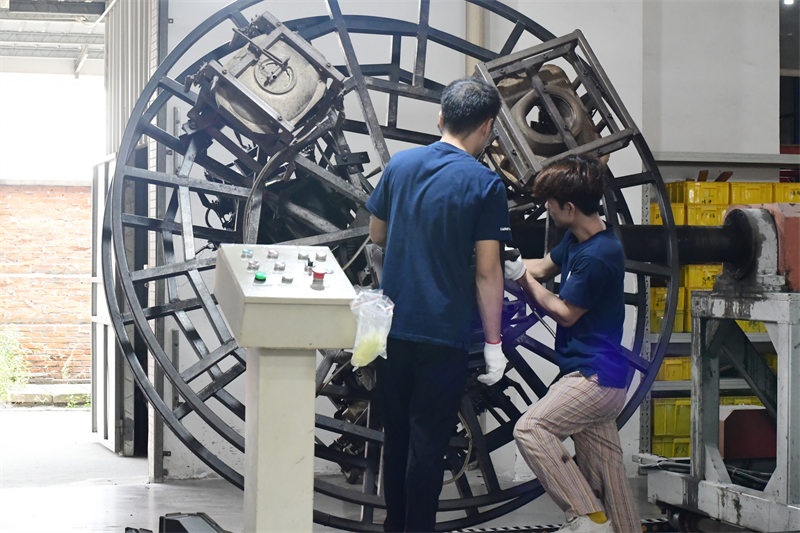How Does the Rotomolding Process Differ from Injection Molding?
 Feb 12,2025
Feb 12,2025

How Does the Rotomolding Process Differ from Injection Molding?
When it comes to manufacturing plastic products, two popular methods often come into discussion: the rotomolding process and injection molding. While both are used to create plastic products, they differ in several key aspects, including the process itself, material usage, production volume, and design flexibility. If you're exploring which method is best for your project, understanding these differences is crucial. In this article, we’ll break down how the rotomolding process stands apart from injection molding.
1.The Basic of Rotomolding Process and Injection Molding Process
Rotomolding, also known as rotational molding, is a unique process used primarily for creating large, hollow plastic parts. The process begins by placing a pre-measured amount of plastic resin, typically in powder form, into a hollow mold. The mold is then heated in an oven while rotating on two perpendicular axes. This rotation ensures that the resin evenly coats the interior surface of the mold, forming a uniform layer. After the resin has melted and adhered to the mold, the mold is moved to a cooling station, where it continues to rotate until the plastic solidifies. Finally, the mold is opened, and the finished product is removed

In contract, Injection molding, is a high-pressure process used to create solid plastic parts. It involves three main components: the injection unit, the clamping mechanism, and the mold. The process starts by feeding plastic pellets into a heated barrel, where they are melted and injected into the mold under high pressure. Once the plastic has solidified, the mold is opened, and the part is ejected. Injection molding is highly efficient for mass production and can produce intricate and detailed parts
2. Key Differences Between Rotomolding and Injection Molding
A. Complexity and Design Flexibility
The rotomolding process excels in creating large, complex, and hollow designs with uniform wall thickness. It allows for intricate details and is highly adaptable to custom shapes. Injection molding, on the other hand, is better for producing smaller, more detailed parts with tight tolerances.
B. Tooling and Production Costs
Rotomolding typically involves lower tooling costs compared to injection molding. The molds used in the rotomolding process are generally less expensive and easier to modify. Injection molding requires more expensive, high-precision molds, making it less cost-effective for low-volume production.
C. Material Usage
The rotomolding process uses powdered plastic resin, which is heated and evenly distributed inside the mold. This results in minimal material waste. Injection molding, while efficient, can generate more waste due to the need for sprues, runners, and excess material.
D. Production Speed
Injection molding is faster for high-volume production, as the cycle times are shorter. The rotomolding process is slower due to the heating, cooling, and rotation phases, making it more suitable for low to medium production runs.
E. Strength and Durability
Products made through the rotomolding process are known for their durability and impact resistance. The seamless nature of rotomolded items reduces weak points, making them ideal for heavy-duty applications. Injection-molded parts, while strong, may have seams or stress points depending on the design.
3. Applications of the Rotomolding Process
The rotomolding process is widely used in industries requiring large, durable, and hollow products. Common applications include:
- Storage tanks and containers
- Marine buoys and kayaks
- Automotive components
- Playground equipment and outdoor furniture
- Medical and healthcare products
- Smart robotic housings
Injection molding, meanwhile, is preferred for manufacturing smaller, high-precision items like:
- Electronic housings
- Automotive parts
- Consumer goods
- Medical devices
4. Which Method Should You Choose?
Choosing between the rotomolding process and injection molding depends on your project requirements. If you need large, durable, and hollow products with minimal waste, rotomolding is the way to go. For smaller, intricate parts with high precision and faster production times, injection molding is more suitable.
The rotomolding process and injection molding are both valuable manufacturing techniques, each with its own strengths. By understanding their differences, you can make an informed decision that aligns with your production goals. Whether you prioritize durability, cost-effectiveness, or precision, the right method will ensure your project’s success.
If you’re ready to explore this method further, consult with a rotomolding expert at Light Venus to see how it can benefit your next project.
 Tel: 0086-13632687993
Tel: 0086-13632687993  Email: roto@lightvenus.com
Email: roto@lightvenus.com

 Home
Home What Are the Key Factors to Consider When Choosing a Rotomolding Manufacturer
What Are the Key Factors to Consider When Choosing a Rotomolding Manufacturer  You May Also Like
You May Also Like



 Tel
Tel
 Email
Email
 Address
Address








